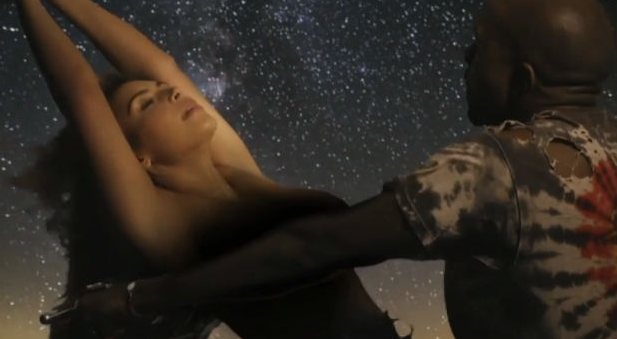Watching Kanye West’s “Bound 2” is about as joyous as romping through a stock photography website. The generic sprawling sunsets, mountain vistas, and gradient backgrounds are airless. Our two protagonists are large as gods, with Kim Kardashian reclining in the buff—though her nipples are airbrushed—playing a human hood ornament atop Kanye West’s motorcycle. These two celebrities, and a growing cadre of other stars, are unlike their predecessors; they like art, and they’re getting treated like artists.
The images from “Bound 2” are wholly without depth, and yet Jerry Saltz has not only named the phenomenon but given it his approval. It’s the “New Uncanny,” and according to Saltz it’s “a freakish act of creation and destruction by appropriation” that’s “as bizarrely gonzo and creepily asexual as Jeff Koons’s hyperrealistic 1991 paintings of himself having sex with his then-wife Cicciolina, John Currin’s 1989 paintings of Breck girls, and Marina Abramovic’s staring at spectators at MoMA in 2010.” While you can compare the video to art—West’s 2007 video “Can’t Tell Me Nothing” tells us he’s not lacking in self-awareness—these aren’t the primary references in the video. Those allude more strongly to the banality of life.
In “Bound 2” what rolls off the tongue are pop cultural references: Michael Jackson and Lisa-Marie Presley’s “You Are Not Alone” moment; the entire hot girls sitting on motorcycles industry; or stock photography websites. It appropriates nearly a full range of low brow culture.
For Saltz, this range is part of what makes the video remarkable, which at its most basic, is about acting like you’re not aware, but are:
The New Uncanny is un-self-consciousness filtered through hyper-self-consciousness, unprocessed absurdity, grandiosity of desire, and fantastic self-regard.
In the New Uncanny, Kim Kardashian’s “nippleless boob” becomes the pinnacle of a “grand gestural show of doing away with concealment, modesty, and self-consciousness, in ways that leave us only with two truly concealed, rather than revealed selves.” Kim and Kanye are giving us their all, but we’re still left with surface and gloss.
That’s nothing immediately new for celebrities, who’ve been at this game for a while. It’s a heightened version of vacuousness with the hope that those aware of the gesture will do some reflecting; Harmony Korine’s empty opus Spring Breakers provides one such example, as does Joaquin Phoenix’s psuedo-documentary I’m Still Here, in which he pretends to leave acting for a career in rapping. In both cases, the false image is so clear that no message is possible. Just because we can identify an art reference or two, bad film and performance isn’t made any more valuable.
In Saltz’s case, he goes on to liken the couple to Jeff Koons and Marina Abramovic for their veiled attempts at sincerity—which is fine, but by continuing to generate a list of people to compare the Wests to, he fails to examine the questions that might tell us why art critics have to talk about celebrities’ artiness in the first place. Rather than giving a new name to a movement, we’d be better off figuring out how critics ended up here.
And the answer may not be that elusive; blame it on the rise of the collector class. Now more than ever, the world’s wealthiest have taken to art as a plaything and pastime; they’re the reason why art fairs and auctions can stay afloat—and keep blue-chip dealers affluent—for most months out of the year. Celebrities have joined the ranks of the hedge-fund managers and barons of industry in their year-long parties and purchasing. (Kanye West just bought a Basquiat, just another ornament to add to the Tree of Wealth.) They’re now part of the art world—talking about their Corbusiers, hiring artists to commission album covers—with art as a branding strategy, a signifier of clout and class.
There’s plenty of additional reasons for wanting to be part of this uber-collector class. Dealer David Zwirner explains one of the rarer rationales as such: “It’s the greatest couples therapy. You see the most wonderful marriages.” I wish Kim and Kanye all the best of luck in that regard, but I’d prefer letting the tabloids keep track.




{ 19 comments }
I basically agree with most of what you write here, but I want to point out that musical artists have been commissioning album cover art from contemporary visual artists for decades–dating back to when album covers were 144-square-inch mini posters. See Sgt. Pepper’s Lonely Hearts Club Band and the White Album, for example.
Dear Corinna Kirsch,
Thank you for quoting me in your article.
You write that I have “given Bound2 (my) approval.” Um, to write on something is not to “approve” something. I did not “approve” Bound2.
I describe a phenomena that I noticed; I point out a disturbance in the uncanny force.
Thank you for reading me,
Jerry Saltz
Jerry: I took “I dig it” to mean “approve,” like “yea” or “nay.” “To dig it” is to approve of an it. From: “The video was ridiculed as clueless kitsch. But I dig it, and I think it represents a part of a collective cultural fracturing, via an idiom that I call the New Uncanny.”
I am very happy to be an avid reader of yours. Thank you for prompting discussion.
Of course he approved of it. He’s just backtracking like he did when he glowingly reviewed Jay-Z’s performance at Pace and then claimed not to have reviewed it. It’s like there are two Jerry Saltzes, the class-conscious art critic who hates the auction houses and the courtier who fawns over the drivel of the rich, and each refuses to recognize the other’s existence.
How did you guys read his review as approval?
“When performers like Kanye West, Kim Kardashian, Lady Gaga, and, yes,
Jeff Koons and Marina Abramovic try so hard to showcase and communicate
how sincere they are, instead they reveal how out-of-touch they are —
from each other, from themselves, from us.” NOW that’s what I call a RINGING ENDORSEMENT….LOL.
I am interested in thinking about how this intersects with ideas of sincerity-as-style and the role of deliberate earnesty in a time of superfluous and meaningless irony (Miley Cyrus licking a hammer). New uncanny == postirony?
Something is wrong with both as style, and both are reactions to each other in a cowardly, parodic way. We are living in complex and emotionally cowardly times eh… I am also really thinking about some ideas of humiliation-entertainment-inspired validation of absurdity and sincerity mentioned in this article “American Psychosis”: (https://www.adbusters.org/magazine/90/hedges-american-psychosis.html)
“It is the ethic of unfettered capitalism. It is the misguided belief that personal style and personal advancement, mistaken for individualism, are the same as democratic equality. It is the nationwide celebration of image over substance, of illusion over truth.”
The author seems to think this is the biggest symptom of a breakdown…the artifice of either irony or earnestness that is so self-aware that it doesn’t try to hide itself anymore…i wonder when will my media stop winking at me and just tell me life is horribly hard.
“I wonder when will my media stop winking at me and just tell me life is horribly hard.” That is a wonderful thought.
Also, I think you put your finger on a bunch of things that made me feel nonchalant or indifferent about this video… ” the false image is so clear no message is possible. ” Perhaps images of aspiration and desire are no longer working and the cultural industry are running out of ideas= enter high art cliches.
I recently ran into an aphorism by charles s. peirce from the 1800s that’s been ringing in my head which may have some bearing here:
“if nature seems highly uniform to us, it is only because our powers are adapted to our desires.”
This struck me because in some ways it seems to make such direct, symmetrical sense (wikipedia tells me peirce was “the father of pragmatism”), but it also flies in the face of what I’ve personally experienced, which don’t make for extremely surprising observations: life’s most exciting/chaotic when my desires exceed my powers and I also find I can reach higher when I don’t know what I can’t do. Nature instead seems most uniform to me when my desires are adapted to my powers.
I came at that aphorism from privately thinking about the meaning of contentment but I’ve also been thinking that, at a certain point, representation of the most basic human aspirations from a position of extreme power can only be banal (and therefore in-human), however self-aware and however well-produced, because the power available so far exceeds what the desire is. It’s hardly a lazy reach. I mean, the actual song “wrecking ball” is a great, simple pop break-up ballad and the actual things that occur in the “bound 2” video are pretty classic: a lot (if not all) of it’s in how they’re delivered that makes these things relatable or meaningless, and that hinges on how much power the person delivering it has and how much risk to them or vulnerability is involved in the expression.
I think I will have a hard time finding anything marina abramovic ever does in the future poignant for a similar reason that I started crying uncontrollably reading a cnn article about a dying teenager’s cover of a katy perry song I hadn’t heard of.
I’m glad that sooooo much discussion is going on about what is really, an advertisement. Kanye’s video is as relevent to our times as a commercial for frozen pizza — only the pizza ad has better music.
“The video was ridiculed as clueless kitsch. But I dig it, and I think it represents a part of a collective cultural fracturing, via an idiom that I call the New Uncanny.”
“I dig it,” is a clear endorsement of the video.
You are pulling a short quote out of a longer context, ditching the nuance so Corinna can Jerry Saltz bash, b/c JerryJerryJerry…..so tedious.
Nobody’s bashing anybody!
Honestly I don’t know how one even addresses “Bound2” at this point (ESPECIALLY re: the “art world”) w/out a discussion of the truly vapid James Franco “parody” (?) [I don’t actually think it is a parody, personally….]. In fact, the Franco thing is so derivative it hurts. Zach Galifinakas and Kanye beat those guys to the punch YEARS AGO…..http://www.funnyordie.com/videos/451fba17e0/cant-tell-me-nothin-from-zach-galifianakis
Actually, Francis’s remarks reinforce my Two-Jerry Theory. Class-Conscious Jerry laments that the video exemplifies how out-of-touch he is with “us.” Courtier Jerry digs it. Like I said, the two of them disdain to acknowledge each other, so I understand the confusion.
Franklin, maybe it is time to just, you know, put the final nail in the Saltz coffin. Maybe pitch an end-all-be-all “J.S. as self-loathing anti-semite” for the New Criterion. I’m sure James Panero would “dig it”!!! 4REALZ!!!
Obvious Troll is obvious.
we’re ALL TROLLZ now, tuff guy.
Comments on this entry are closed.